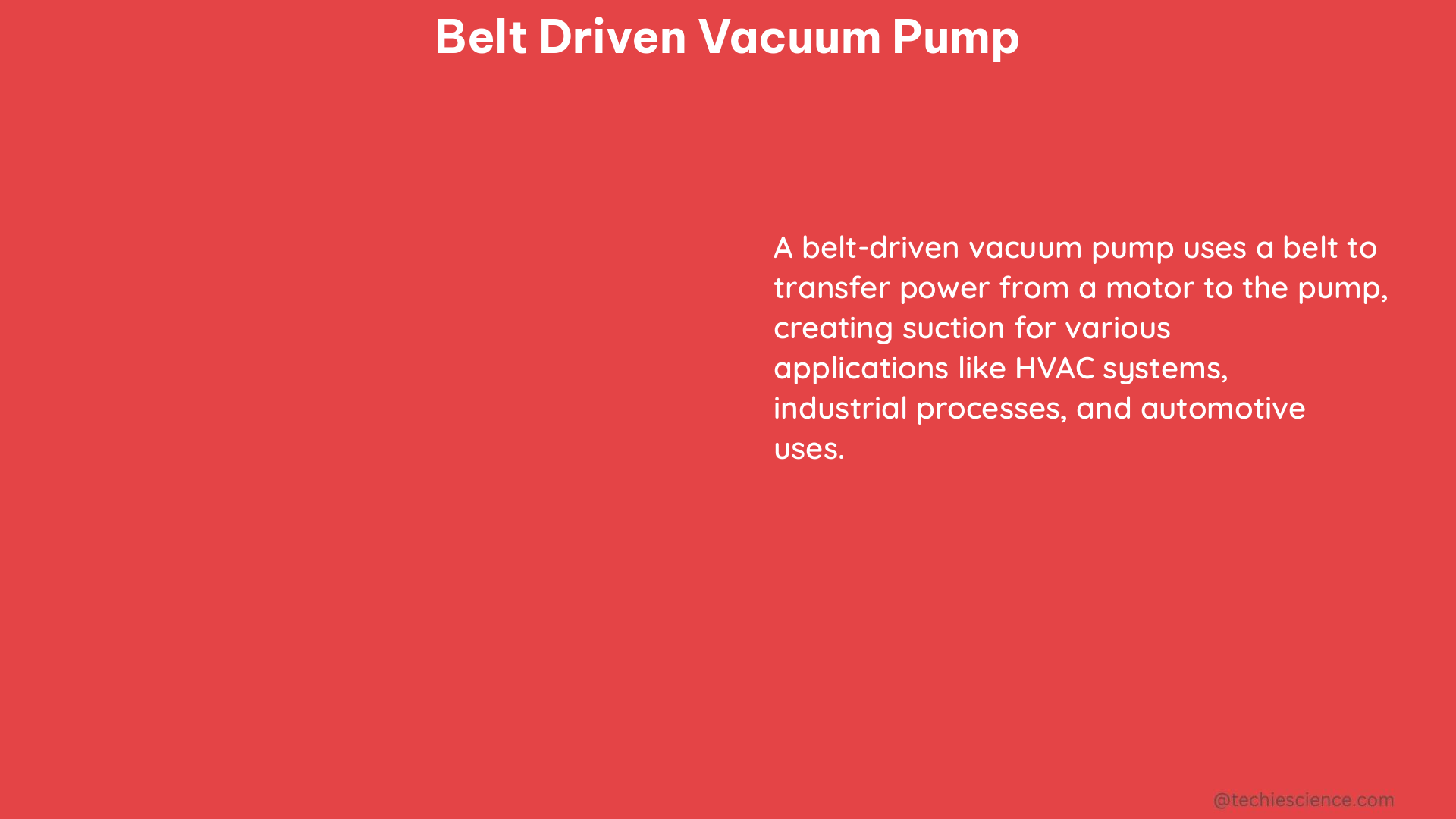Belt-driven vacuum pumps are a popular choice for various applications, from laboratory setups to industrial processes. These pumps leverage the power of a belt to drive a rotor, creating a vacuum by removing air from a chamber. With a volumetric flow rate of up to 6 CFM (cubic feet per minute) and the ability to decrease the absolute pressure from 760 Torr to 1 Torr, these pumps offer impressive performance capabilities.
Understanding the Technical Specifications
When it comes to belt-driven vacuum pumps, the technical specifications play a crucial role in determining their suitability for a particular application. Let’s dive into the key details:
Volumetric Flow Rate
The volumetric flow rate of a belt-driven vacuum pump is a measure of the volume of air that the pump can remove from the vacuum system per unit of time. The typical range for these pumps is between 2 CFM to 6 CFM, with higher-end models capable of reaching the upper end of this spectrum.
Pressure Range
The pressure range of a belt-driven vacuum pump is the difference between the atmospheric pressure (760 Torr) and the lowest achievable pressure. These pumps can typically decrease the absolute pressure from 760 Torr down to 1 Torr, providing a wide range of vacuum levels for various applications.
Pump Size and Intake Port
The size of the belt-driven vacuum pump and the diameter of its intake port can significantly impact its performance. Larger pumps with larger intake ports generally have a higher volumetric flow rate and can handle higher vacuum loads more effectively.
Power Requirements
Belt-driven vacuum pumps require a power source to operate, and the specific power requirements can vary depending on the model and manufacturer. It is essential to ensure that the power supply is compatible with the pump’s specifications to ensure safe and efficient operation.
DIY Installation and Maintenance

When it comes to installing and maintaining a belt-driven vacuum pump, there are several crucial factors to consider:
Pump Placement
The location of the pump within the vacuum system is crucial. It should be placed in a well-ventilated area, away from any heat sources or potential obstructions that could impede airflow. Proper placement can help optimize the pump’s performance and extend its lifespan.
Power Supply
Ensuring the correct power supply is essential for the safe and efficient operation of the belt-driven vacuum pump. The power source must match the pump’s voltage and amperage requirements, as specified by the manufacturer.
Maintenance and Troubleshooting
Regular maintenance is crucial for maintaining the optimal performance of a belt-driven vacuum pump. This includes cleaning the pump, checking the belt tension, and replacing worn or damaged parts as needed. Troubleshooting common issues, such as decreased suction power or unusual noises, can help identify and address any problems before they escalate.
Factors Affecting Pump Performance
The performance of a belt-driven vacuum pump can be influenced by several factors, including:
Vacuum Load
As the vacuum inside the system or chamber increases, the availability of air molecules to be removed decreases. This can lead to a gradual decline in the pump’s performance, as it becomes more challenging to maintain the desired vacuum level.
Intake Port Size
The size of the intake port on the vacuum pump can significantly impact its ability to handle higher vacuum loads. Larger intake ports generally allow for better airflow and higher volumetric flow rates.
Building Material Quality
The quality of the materials used in the construction of the belt-driven vacuum pump can also affect its performance. High-quality components, such as bearings, seals, and rotors, can contribute to improved efficiency and longer lifespan.
Choosing the Right Pump
When selecting a belt-driven vacuum pump for your DIY project or application, it’s essential to consider the following factors:
- Intended use and vacuum requirements
- Desired volumetric flow rate and pressure range
- Power supply compatibility
- Pump size and intake port dimensions
- Reputation and quality of the manufacturer
By carefully evaluating these factors, you can ensure that you choose the right belt-driven vacuum pump for your specific needs, ensuring optimal performance and long-term reliability.
Conclusion
Belt-driven vacuum pumps are a versatile and efficient solution for a wide range of applications, from laboratory setups to industrial processes. By understanding the technical specifications, proper installation and maintenance, and factors affecting pump performance, DIY enthusiasts can successfully integrate these pumps into their projects and achieve the desired vacuum levels with confidence.
Remember, when it comes to belt-driven vacuum pumps, attention to detail and the use of high-quality components are key to ensuring reliable and long-lasting performance.
References:
- DEPARTMENT OF DEFENSE – ASSIST-QuickSearch – DLA. (n.d.). Retrieved from https://quicksearch.dla.mil/ImageRedirector.aspx?token=5751774.36028
- TDIClub Forums. (n.d.). Retrieved from https://forums.tdiclub.com/index.php
- Sanatron. (n.d.). Rotary Vane Vacuum Pumps, The Definitive Guide. Retrieved from https://www.sanatron.com/articles/vacuum-pumps/rotary-vane-vacuum-pumps-the-definitive-guide.php
- Lab Manager. (n.d.). Evolution Of The Laboratory Vacuum Pump. Retrieved from https://www.labmanager.com/evolution-of-the-laboratory-vacuum-pump-19365
- Welch Vacuum. (n.d.). Belt-Driven Pump FAQs. Retrieved from https://www.welchvacuum.com/en-qa/belt-driven-pump/che

The lambdageeks.com Core SME Team is a group of experienced subject matter experts from diverse scientific and technical fields including Physics, Chemistry, Technology,Electronics & Electrical Engineering, Automotive, Mechanical Engineering. Our team collaborates to create high-quality, well-researched articles on a wide range of science and technology topics for the lambdageeks.com website.
All Our Senior SME are having more than 7 Years of experience in the respective fields . They are either Working Industry Professionals or assocaited With different Universities. Refer Our Authors Page to get to know About our Core SMEs.